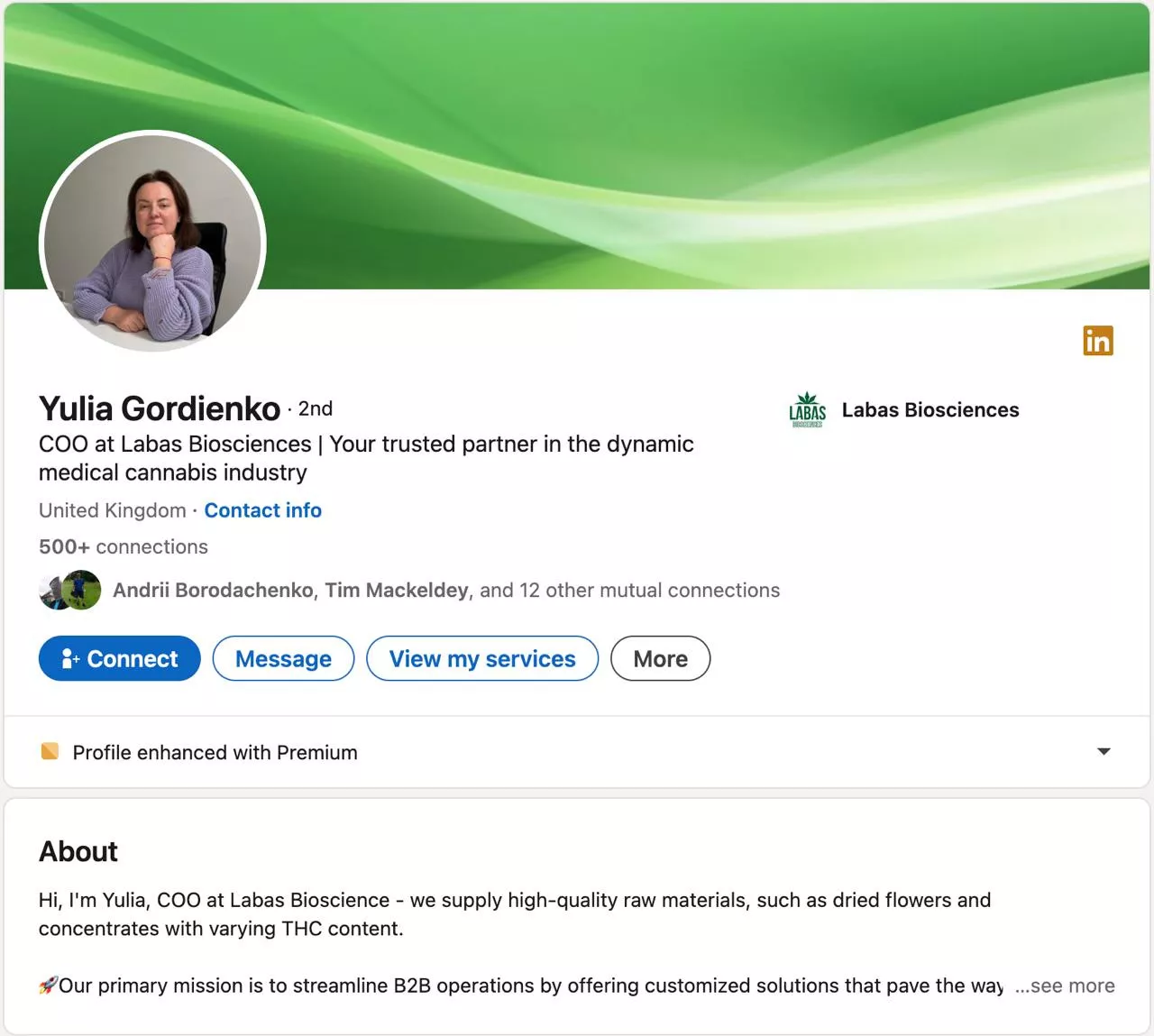How to Sell on LinkedIn and Get a 50% Close Rate: B2B Lead Generation Case Study for Labas Biosciences
The client
Labas Biosciences is a start-up company that acts as an intermediary between medical cannabis companies and reputable distributors. Labas Biosciences understands the nuances of the medical cannabis market and is committed to quality, transparency, and innovation.
The challenge
As the startup was just beginning to develop, its owners had no experience promoting themselves in the niche. They were primarily working with cold lead generation. Therefore, we had several tasks:
- Create a lead generation process.
- Build a personal brand and reputation so that Labas Biosciences will be better positioned in the niche.
- Gain experience, both for ourselves and the client, creating and sharing content about Labas Biosciences on LinkedIn.
- Attract the company's first customers.
Campaign objective
Labas Biosciences' main goal was to create a lead generation process and attract potential customers, and LinkedIn was one of the fastest tools to achieve this.
We considered other options, but many of them either did not fit the niche or could only provide results in the long term. Therefore, we found LinkedIn and email to be the best way to track weekly progress for this client.
To begin, we analyzed the niche and its related opportunities and determined the following:
- The approximate size of the target databases of companies and contacts.
- Competitors in the niche on the platform.
- The main target information to be included in the marketing materials, such as presentations, commercial offers, banners for the website, and social networks.
- Several variants of communication cards.
- A development strategy for lead generation on LinkedIn.
- Plans for further developing the LinkedIn SMM (promotion and content of pages).
Team strategy
At the beginning of our cooperation, we received a starter kit containing a landing page, a brand book, and a rough portrait of Labas Biosciences' target audience. Thanks to our close collaboration with the client, we successfully completed all preparatory and organizational stages within the first month and moved on to the active phase of newsletters.
Pre-launch stage
1. Creating LinkedIn and email accounts, warming them up, increasing activity, and filling them with content.
2. Connecting the accounts to WeConnect, Expandi, and Dripify automation tools. These tools help increase send volume and speed, make the accounts more secure, and prevent the newly created accounts from getting blocked.
3. Market analysis and selection of an ideal customer profile (ICP) for Labas Biosciences. We created several of them and gradually refined them. We also chose a communication style and several message templates.
4.Compiling the database according to the selected ICP and coordinating it with the partner.
5. Setting up technical requirements for emails by the partner. This is necessary to ensure that emails do not end up in spam and that mailboxes are not blocked by operators.
6. Writing several variants of scripts for the selected ISR and creating potential calls to action (CTA). We also worked out hypotheses about the style of communication that can produce results.
7. Creating and launching newsletters.
8.Creating reports for the partner.
Launch of the newsletters
The target audience was pharmacies and shops authorized to sell cannabis and medical products. These were discussed and agreed upon with the partner.
We sent up to four messages to each lead via LinkedIn and up to three via email. As part of our workflow, we processed the responses from the leads. We then set up meetings with interested clients, and Labas Biosciences representatives conducted them.
Next steps
Once we had our first hot leads, we worked to create a LinkedIn SMM plan for better conversion and brand development on LinkedIn.
1. First, we created a content plan for posting to personal and business accounts on LinkedIn. Personal accounts are necessary for sending newsletters and building a professional's personal brand and credibility. A business account is a representative page for the company. It is created so that potential leads can see what the company does, how it works, and get information on company products and news.
An example of a personal account created specifically for the case to illustrate our work
2. We then created a guide for our partner on how to write posts on LinkedIn: what to include in texts, the writing algorithm, and how to get prospects interested in the product offering.
Promotion results
In just over six months, we managed to build a lead generation system.
1. Labas Biosciences held 43 meetings with potential clients. Of these, we were able to close deals with 25 customers. That means the startup got a conversion rate of more than 50% and grew its personal brand on LinkedIn from scratch.
2. In five months of mailings, we achieved the following numbers:
- 2200 targeted contacts
- 3700 messages
- 498 responses
The number of targeted contacts was limited due to the nature of the client’s product.
3. Over the course of our relationship, the company grew from a start-up to a full-fledged vendor with enough advantages over its competitors.
Conclusions
- Labas Biosciences received a new independent lead generation channel that was built from the ground up in a short period of time.
- Thanks to a detailed niche analysis, a thorough development strategy, and sufficient marketing materials, we were able to attract the first customers for the startup via LinkedIn.
Related Articles
How to Set Up Consent Mode in GA4 on Your Website with Google Tag Manager
Let's explore how to properly integrate consent mode in GA4, configure it for effective data collection, and at the same time comply with GDPR and other legal regulations
Display Advertising Effectiveness Analysis: A Comprehensive Approach to Measuring Its Impact
In this article, I will explain why you shouldn’t underestimate display advertising and how to analyze its impact using Google Analytics 4
Generative Engine Optimization: What Businesses Get From Ranking in SearchGPT
Companies that master SearchGPT SEO and generative engine optimization will capture high-intent traffic from users seeking direct, authoritative answers





